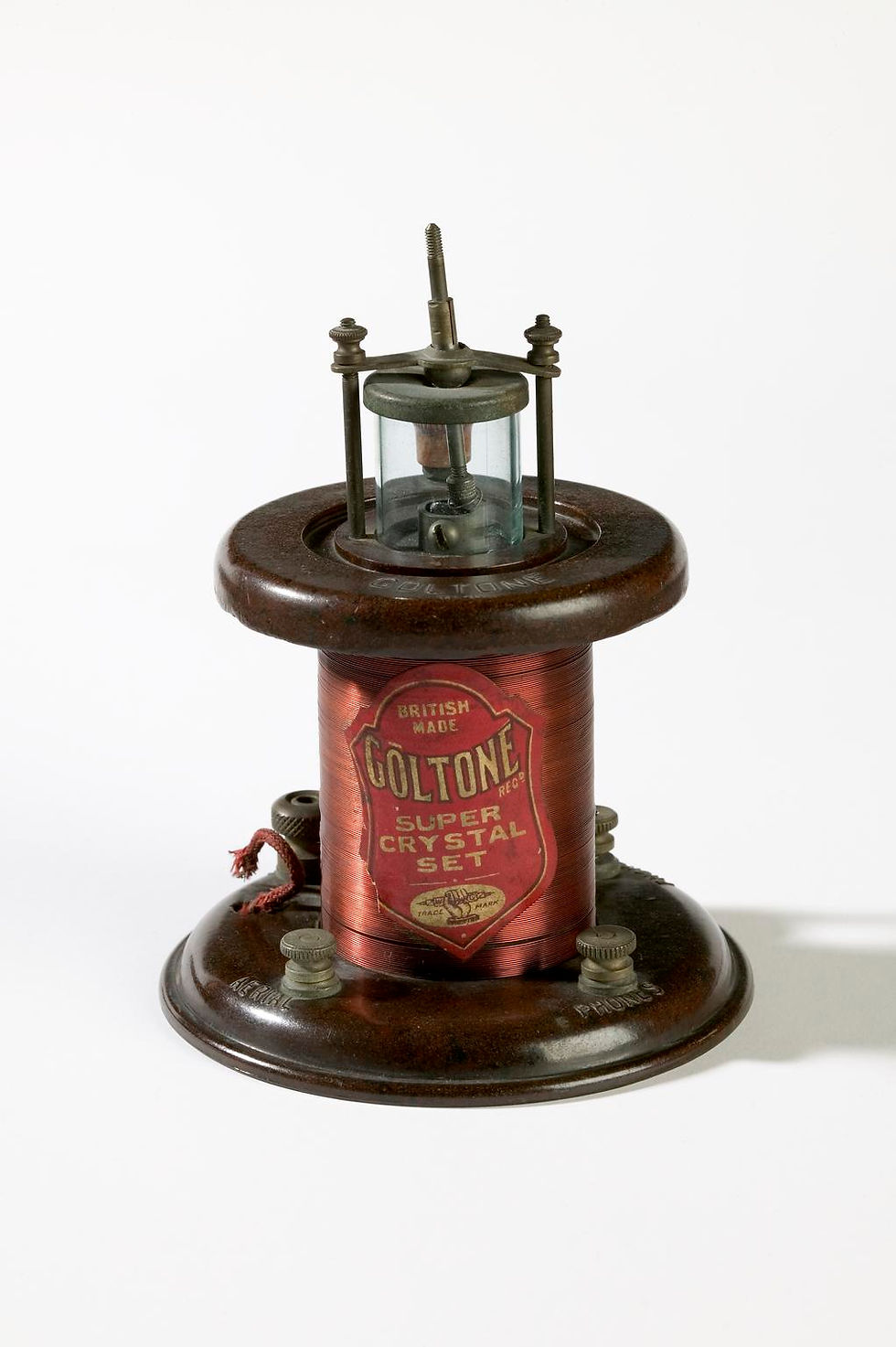There is a long history of spiritualists using new kinds of technologies to enhance their abilities to communicate with entities beyond the veil. During my collaboration with Christine Ferguson and Emma Merkling for the project The Media of Mediumship, we explored this history in depth.
In many cases the inventors behind these technologies were well aware of the fact that their new devices would be used for these unorthodox purposes. In fact, some figures openly promoted the use of their technologies for spiritualistic activities. Typewriters, cameras, telegraphs, and telephones were just some of the kinds of equipment spiritualists brought into the séance room.
While I would love to talk about each of these technologies in detail, it would be far too long a discussion for a short blog. Instead, I want to focus squarely on crystal radios.

SOURCE: Goltone Crystal Radio Receiver, made by Ward & Goldstone Ltd, Salford, c.1923.
Several influential developers of telecommunication technologies were directly involved in spiritualism and psychical researcher.
Oliver Lodge, the renowned Victorian physicist and pioneer of wireless technologies, was extremely open about his devotion to spiritualism and interest in psychical research. During the 1880s Lodge was a member of the elite social group known as the Ghost Club. He also served as President of the Society for Psychical Research in London from 1901 to 1903.

SOURCE: Portrait of Oliver Lodge
Lodge even published what would become a bestselling book titled Raymond or Life After Death (1917), which described in detail his experiences communicating with the supposed spirit of his dead son Raymond, who died while serving for the British military during the First World War. For these spiritual communications Lodge hosted séances with the famed medium Gladys Osborne Leonard.

Book Cover for Raymond or Life After Death (1917)

SOURCE: Portrait of Raymond Lodge in his Military Uniform
In the later decades of the nineteenth century, many physicists become proponents of ether theory. Ether was believed to be an element or all-encompassing energy through which light travelled and surrounded and connected all living and non-living objects. By theorizing that ether connected the universe and conducted electromagnetic energy, these nineteenth-century scientists were able understand light’s wave and particle functions.
But ether theory also supported spiritualist views, it was argued that ether made it possible to communicate with spirits beyond the veil. Lodge came to believe that the spirit world existed in the ether and it played a key part in his understanding of how new communication technologies could be used to speak with the dead.
Lodge’s interest in spiritualism eventually intersected with his professional interests in radio broadcasting, and this did not go unnoticed by his contemporaries. For example, in 1926 the former British officer and expert in wireless telegraphy Cyril Jack Frost stated that his deep interest in the possibility of using radio transmissions to communicate with spirits was aroused by reading Lodge’s writings.
Frost would also become a significant figure within the spiritualist community publishing several works on the topic and delivering popular lectures around the UK.

SOURCE: Portrait of Thomas Alva Edison by Abraham Archibald Anderson (1890)
In the United States Thomas Edison was also interested in the connection between communication technologies, such as radios, and spiritualism. Edison, whose celebrated inventions included the phonograph, the first practical incandescent lamp, and a carbon button transmitter for telephones, announced his intention, in 1920, to create a spirit communication device. Essentially, it was to be a specially designed telephone that could pick up spirit communications. Unfortunately, his ambitions never led to the creation of this new technology.

SOURCE: Photograph of Thomas Alva Edison with his Phonograph, Taken in Mathew Brady's Washington, D.C. studio (1878)
However, other technologies were appropriated into spiritualist activities. The popular Brownie Crystal Receiver, manufactured by the London-based J.W.B. Wireless Company is another good example to consider here.

SOURCE: Brownie Crystal Receiver (1924)
It was a popular radio to be used by spiritualists during the 1920s to communicate with entities beyond the veil. These devices, which became important tools for the modern technologically savvy spiritualist, had something in common with aspects of spiritualist theories regarding communications with the dead: much like mediums under trance, they seemingly functioned via some unseen energy, so the sounds they picked up could be reinterpreted as supernatural in origin. In reality, crystal radios did not require energy sources such as electrical outlets to function because they were powered by radio waves.
So, there you have it, a brief history of the spiritualism and its use of communication technologies. For more information visit the Media of Mediumship’s website. You can also listen to this interview between myself and Dallas Campbell for an episode of History Hit's popular podcast Patented: History of Innovations.
REFERENCES
Lodge, Oliver. Raymond or Life and Death: With Examples of the Evidence for Survival of Memory and Affection after Death. London, Methuen & Co, 1916.
Natale, Simone. Supernatural Entertainments: Victorian Spiritualism and the Rise of Modern Media Culture. University Park: Pennsylvania State University Press, 2016.
Noakes, Richard. Physics and Psychics: The Occult and the Sciences in Modern Britain. Cambridge: Cambridge University Press, 2019.
Oppenheim, Janet. The Other World: Spiritualism and Psychical Research in England, 1850-1914. Cambridge: Cambridge University Press, 1985.
Comments